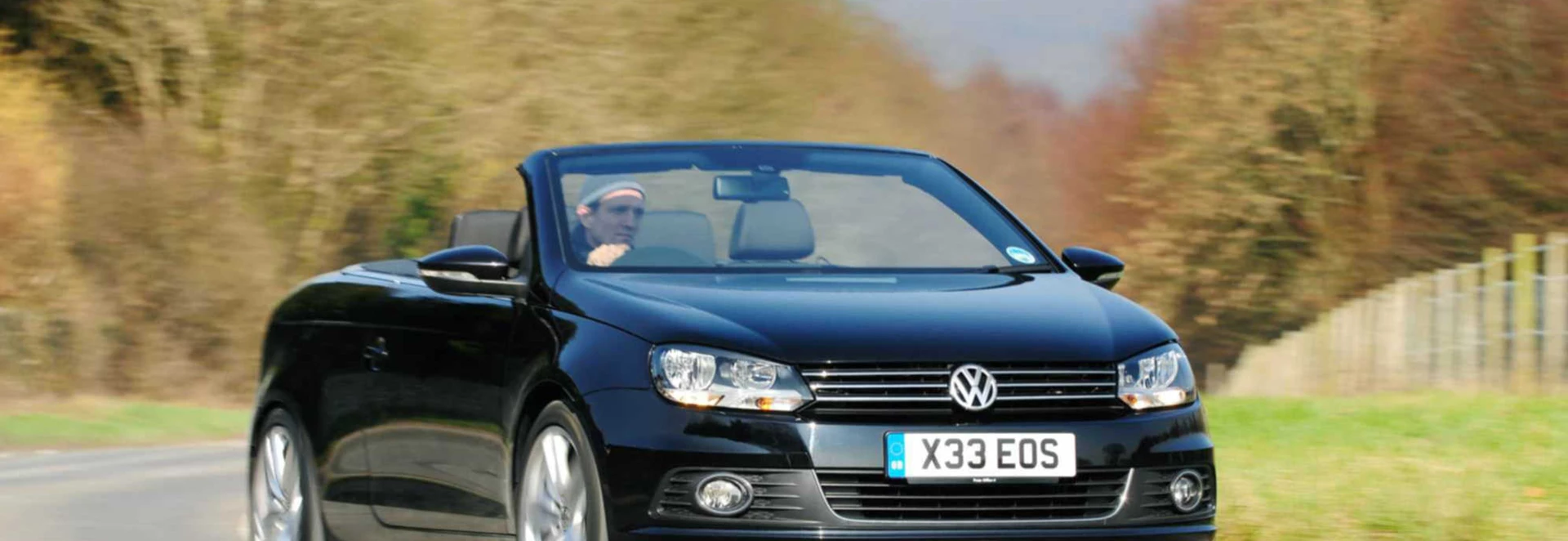The Eos is the only one of several coupe-convertibles introduced in the middle of the last decade to have survived to the present day. Its part-metal, part-glass roof consist of five major parts and well over four hundred much smaller ones, and can be opened or closed in 25 seconds, either by pressing a button inside the car or, if you've specified the keyless entry option, remotely.
Volkswagen designed the Eos as a convertible right from the start. It's not the open-topped version of any other product, and in fact uses Golf suspension at the front and Passat at the rear (previous versions of those cars in each case).
Not all the engines previously found in the Eos are still available - there's no longer a 3.2-litre V6, for example. What remains are a 2.0-litre TDI diesel and 1.4- and 2.0-litre TSI petrols, all turbocharged. Six-speed semi-automatic DSG transmission is an option with the larger engines. All versions are front-wheel drive.
Performance
The maximum power outputs of the engines mentioned above are quite well-spaced. The quickest Eos by some margin is the 208bhp 2.0-litre TSI, which has a top speed of 148mph and a 0-62mph time of 7.8 seconds. The equivalent figures for the 158bhp 1.4-litre TSI are 135mph and 8.8 seconds, while the 138bhp diesel, both the least powerful and the heaviest car in the range, is noticeably more leisurely at 129mph and 10.3 seconds.
The DSG gearbox adds weight but has quicker changes than can be achieved with the manual. These aspects cancel each other out as far as acceleration is concerned, so there is no overall effect on the 0-62mph times. DSG cars have slightly lower top speeds, but never by more than 2mph, and that's not going to make a difference to anyone.
One thing to bear in mind about the diesel is that although it's the slowest Eos when being driven flat out, it's a lot more powerful than the petrol cars below 2000rpm. In gentle motoring that's the sort of engine speed you're likely to use most of the time, and in these circumstances the diesel could actually feel like the best performer of them all.
Ride and Handling
There's a slight shimmy through the steering when the roof is folded down, though it's apparently only during vigorous cornering.
The Eos is a car to be enjoyed at a moderate pace rather than one that responds well to hard driving. It isn't sporty, but the major controls are nicely weighted and the front/rear balance is good. There's a slight shimmy through the steering when the roof is folded down, though it's apparently only during vigorous cornering. 18-inch wheels are standard equipment on all versions, which is rather a pity because although they don't affect the ride quality too much they make the Eos feel clumsy. 17-inch wheels, available as an optional extra, are well worth considering.
Interior and Equipment
The Eos is named after the Ancient Greek goddess of the dawn, sister of Helios (sun) and Selene (moon).
There are two trim levels, called Sport and Exclusive. Sports are reasonably well equipped, with manual air-conditioning, DAB digital radio, Bluetooth connectivity, USB and iPod sockets, remote boot unlocking, automatic headlights, rear parking sensors and a hill hold function. Exclusive models, only available with the diesel engine, get air-conditioning, leather upholstery, heated front seats and a different alloy wheel designs. Both have a removable wind deflector which does a good job of calming down the airflow inside the car but completely blocks access to the rear seats, though there's very little room for passengers back there in any case. Luggage space is limited too. With the roof up the boot has a capacity of 380 litres, but this falls to 205 litres when the roof is tucked away.
Cost
Its official figures are 58.9mpg and 125g/km, which equates to £110 in Vehicle Excise Duty.
The diesel engine is the most expensive option, partly because that's how diesels are but partly also because they have battery regeneration and start/stop, which isn't available on the petrol cars. DSG has quite a serious effect on the fuel economy and CO2 emissions, so if you want the lowest running costs in the range you're going to have to go for a diesel manual. Its official figures are 58.9mpg and 125g/km, which equates to £110 in Vehicle Excise Duty. The diesel with DSG is considerably more expensive to run, but less so than any of the petrol cars. The 2.0-litre TSI DSG has the worst figures of 37.7mpg and 174g/km.
Our Verdict
Volkswagen UK sold 5,648 examples of the Eos in 2007, its first full year of production. It hasn't matched that since, and probably won't in future, so there will always be a certain rarity value. Beyond that, the Eos isn't at all practical, and could be considered a two-seater even though there's technically room for four people, but it looks good, it's nice to drive and the roof arrangement is very clever. Definitely worth looking at for fans of comfortable, open-topped transport.




